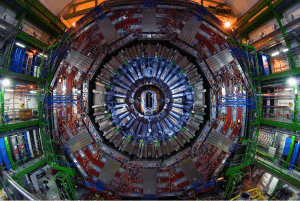
There is growing evidence that there may be more than one type of Higgs boson.
Source: CERN (http://cds.cern.ch/record/1344500)
As the excitement surrounding the recent discovery of the long-sought Higgs boson fades, evidence is building to support the notion that there may be more than one type of Higgs boson.
Thought to imbue subatomic particles with mass via the Higgs field, the Higgs boson has been of particular interest to the physics community in recent years, motivating—in part—the construction of the Large Hadron Collider (LHC) in Switzerland. However, the details of the Higgs’ role in the Standard Model remain unclear.
Despite the publicity the multiple-Higgs hypothesis is now receiving, the possibility of modifying the preliminary Higgs theory has been acknowledged for some time. Variations on the Standard Model have introduced the opportunity on numerous occasions. One notable example proposed in 1980s is the Minimal Supersymmetric Standard Model (MSSM), modified with the principle of supersymmetry (1). According to supersymmetry, subatomic particles, such as fermions or bosons like the Higgs particle, have cousin particles known as superpartners. While different in spin, a quantum state, proposed superpartners are identical to their counterparts in all other characteristics (2). Interestingly though, the MSSM predicts the existence of five distinct Higgs bosons. According to the MSSM, there would be two types of CP-even (meaning even in charge and parity) Higgs particles, one CP-odd Higgs, and two oppositely charged Higgs bosons (3).
To further complicate the problem, yet another proposed version of the Standard Model, the Next-to Minimal Supersymmetric Standard Model (NMSSM) asserts that there may only be two variations of the Higgs boson (4). Problematically, until the first operation of the LHC in September of 2008, theoretical physicists had few modes of exploring the veracity of their hypotheses. But since the Atlas and CRM experiments began, confirming the existence of a particle in the predicted Higgs mass region of 125-126 GeV on July 4, 2012, experimental data have become both accessible and applicable to previously proposed theories.
In mid-December of 2012, researchers at the LHC released data demonstrating bizarre results in Higgs boson decay. As expected, the bosons observed in the experiment released two photons upon decay, but interestingly, some of the bosons decayed at a rate nearly double that which the researchers anticipated (5). Additionally, the experiments determined the mass of the Higgs boson to be both 126.6 GeV and 123.5 GeV because some of the particles were preferentially decaying into Z bosons (a particle that mediates the weak nuclear force). The divergence of mass demonstrated by the experiment would seem to confirm that there are at least two variations of the Higgs boson.
Researchers at the LHC, however, were not eager to rush to the same conclusion. As the evidence comes in direct conflict with the theorized nature of the Higgs boson presented by Peter Higgs and his colleagues in 1964, measures are being taken to ensure the reliability of the data. Some CERN researchers believe that it merely stems from a mechanical error in the LHC detectors. Either way, the results have yet to be reproduced, casting doubt upon the evidence (5).
Looking to the future, with the LHC currently under construction, only experiments using higher energy beams will be able to probe for heavier variations of the Higgs boson or attempt to recreate the results found in December (6). Reopening in 2015, the LHC will operate at a collision energy of 13 TeV, an increase of 5 TeV over the previous maximum of 8 TeV reached in 2012 (7).
While the future of supersymmetry and the Higgs boson is unclear, if supersymmetry is indeed a characteristic of the Standard Model, then it is plausible that physicists have already observed the superpartner of the Higgs boson. However, if further research shows that only a single Higgs boson exists and that supersymmetry is little more than a convenient solution, then physicists must return to the drawing board. The Standard Model remains incomplete and a unified theory elusive, but regardless of whether or not there is a lone species of Higgs boson, finding the answer brings us one step closer to a deeper understanding of the universe.
References:
1. Lincoln, Don. “The Higgs Boson…or a Higgs Boson?” (2013). Available at http://www.pbs.org/wgbh/nova/next/physics/higgs-boson-discovered/ (22 April 2013).
2. Lincoln, Don. “Supersymmetry: Looking in Nature’s Mirror” (2012). Available at http://www.pbs.org/wgbh/nova/physics/blog/2012/07/supersymmetry-looking-in-natures-mirror/
3. A. Djouadi et al., Computer Physics Communications. 108, 56-74 (1998).
4. S.F. King et al., Nuclear Physics B. 870, 323-352 (2013).
5. Moyer, Michael, “Have Scientists Found 2 Different Higgs Bosons?” (2012). Available at http://blogs.scientificamerican.com/observations/2012/12/14/have-scientists-found-two-different-higgs-bosons/ (22 April, 2013)
6. Pappas, Stephanie, “Second Higgs Boson? Physicists Debate New Particle” (2013). Available at http://science.nbcnews.com/_news/2013/04/13/17735790-second-higgs-boson-physicists-debate-new-particle?lite (22 April 2013).
7. Anthony, Sebastian, “CERN begins LHC upgrade, to hopefully ‘change our understanding of the universe’” (2013). Available at http://www.extremetech.com/extreme/152326-cern-begins-lhc-upgrade-to-hopefully-change-our-understanding-of-the-universe (22 April 2013).